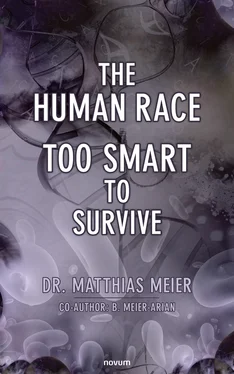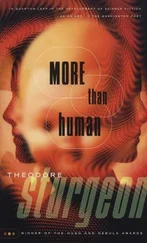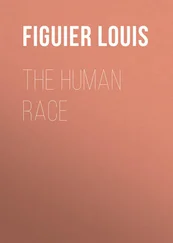It was recently discovered that the oldest man-ape that walked on two legs lived in the Allgäu region in Germany about twelve million years ago. After twelve million years of evolution, the result is disease and pain? Genetics is there to ensure that a species adapts better to its environment from generation to generation, so that each is stronger than the one before it. Is that the case in our society? In the U.S., there are predictions of a generation emerging now that, for the first time in human history, will not outlive its parents. Current figures from the CDC in the U.S. show that 6 in 10 adult Americans have one chronic condition and 4 in 10 have two or more (1–4). 54% of U.S. children have a chronic disease and 21% have developmental disabilities. Annual cancer diagnoses have hit 1.6 million with 600,000 resulting deaths in the U.S. Autoimmune diseases are on the rise every year. One in four people die from heart disease, one in ten have liver disease, one in twenty have depression, 12% have thyroid dysfunction, 40% are diabetic, and 74% have chronic intestinal dysfunction! We as a population are expected to accept this, just as we are expected to accept drug treatment without addressing the causes. In 1971, U.S. President Richard Nixon launched an initiative called “The War on Cancer”. 50 years have passed since then, and the result? Today, more people are getting cancer than ever before. The WHO even warns that cancer incidence will double by 2040! How often do we hear news of being on the verge of a breakthrough in cancer treatment? Yet another new drug that is supposed to bring us a little closer to a cure, but ultimately disappoints. Americans today are now the sickest species in the history of our planet, and there are reasons for this. However, they are not genetic as we are so often led to believe. Even if the numbers in Europe are still lagging somewhat behind, we should at least be aware of the consequences our lifestyle has, not only for the individual, but also for society in general and the future of our species. If we adopt adequate measures, a long and healthy life without chronic diseases, medication and prolonged suffering is possible even for Central Europeans and Americans. But before we get into the causes of diseases and their solutions, first a brief digression into the history of medicine that paints a picture of how we came to our present-day conception of disease, health and medicine.
For about 120 years, our health care system has been dominated by allopathic medicine, which teaches that the human body will eventually get sick, wear out, and that drugs, surgery, or other examinations/interventions are necessary to keep symptoms at bay. It is reductionist, which means that it only sees and treats the symptom, not the cause, which is a big difference from a holistic view of human physiology. There is hardly a person alive who remembers the time before “modern” medicine. In the 19th century, people were treated primarily by homeopaths, “herbal witches”, magnet healers, shamans, etc. For the most part, they had a respectable reputation and, through their way of practicing medicine, had the goal of relieving people of their illnesses, thus possessing healing intentions. At the end of the 19th century, osteopathy and chiropractic were developed into a real doctrine and applied to people structurally, even if sometimes under bizarre circumstances (the first chiropractor credited a dead man with introducing him to the practice). In the U.S., it was considered a career leap for doctors at that time to study in Europe, especially in Germany, and to join and learn from the experts known at the time (Robert Koch, Paul Ehrlich, and Louis Pasteur). Upon their return to the U.S., lucrative positions in various offices or private practice with higher earning potential beckoned.
In the wake of industrialization, billionaires like J. D. Rockefeller and A. Carnegie had to deal with the socioeconomic benefits of their wealth. Both invested philanthropically in social projects aimed at promoting and preserving labor for the labor market, thus benefiting their own capitalist thinking in the long run. Among other things, they invested in science and research because the status of medical schools did not meet modern standards at the time. The goal was to bring the U.S. out of the shadow of the Europeans, to promote research and teaching in medicine, to remove competing types of medicine from mainstream thinking, and to establish the medicine we know today as the only recognized type of “healing practice.” This allowed allopathic medicine to take hold during the first decades of the 20th century, which was then divided into different specialties by the further development of technology. For example, only doctors with considerable experience could use an ophthalmoscope and accordingly interpret and treat changes in the ocular fundus. The result of this increasing specialization meant that medical practitioners dealt with smaller and smaller sections of the human body and integrated less and less of the whole person into their evaluations and treatment, but their salaries and standing among the population continued to rise. The mood among the various groups practicing medicine became increasingly aggressive. As more and more states, under the leadership of the AMA (American Medical Association), granted licenses to practice medicine only to physicians with medical degrees, chiropractors were sometimes thrown in jail on charges that they were practicing medicine without a license. This kind of aversion, and sometimes even aggressiveness, towards competing healing professions has persisted to this day. Chiropractic, osteopathy, acupuncture, homeopathy or clinically verified medical nutritional science are neither taught in medical school nor in residency training, yet many physicians make judgments (often negative) about the various groups and pass this opinion on to patients, even though they do not know what the individual treatment looks like or how it works. Only a few doctors, osteopaths, chiropractors, naturopaths, environmental physicians, and some therapists have the knowledge of these natural ways of influencing health, because they took it upon themselves to further their own education.
Time and again, patients notice that fasting, Ayurvedic cures, acupuncture, chiropractic or high-quality nutritional supplements can improve their symptoms or, in some cases, make them completely symptom-free. All over the world there are reports of “miracle cures” of diseases such as cancer, arthritis, rheumatoid arthritis, autoimmune diseases, Parkinson’s and others. But mainstream medicine remains steadfast, does not ask questions, and does not integrate natural medicine into existing standards. For the most part, the population does not find its way to so-called “alternative medicine” despite increasing dissatisfaction with medical care of chronic diseases. Osteopathy and acupuncture have acquired a certain acceptance among the population, although the understanding of the physiology behind them is largely lacking, both among patients and many physicians. Whether or not the patient is advised to pursue these options often depends on the opinion or feeling of the physician, who has no personal knowledge of these treatments. How could they? After all, these are not covered in their education. In the U.S., chiropractic and osteopathy are studies comparable to classical medical studies. The only difference is that all manual medical techniques are also taught in seminars and thus contain even more learning material than a medical degree. Like medical studies, both programs end with a doctorate. Furthermore, chiropractors have almost twice as many hours of physiology and anatomy classes as medical students. Notably, chiropractors are taught far less about pharmacology and thus are not allowed to prescribe medications, although there is currently a trend in the U.S. to integrate them into the pharmaceutical business in order to weaken the naturopathic base.
Читать дальше












